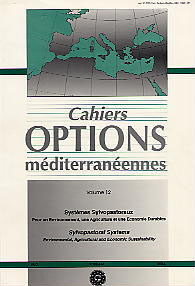| Article précédent | p. 45-48 | Article suivant |
Development of grazing-type lucerne: yield variation and relationship with plant morphology in the Medicago sativa complex
For agronomic, economic and environmental reasons the development of lucerne varieties adapted to grazing could meet the demand for a more extensive, sustainable agriculture. In this sense, a breeding programme activated at Lodi has carried out the evaluation for plant morphology and dry matter yield of a large collection of accessions belonging to different taxa of the Medicago sativa complex. The 'taxonomic' groups were rather differentiated both morphologically and productively. The subsp. X varia and the artificial crosses between different taxa combined an interesting morphology with good productivity. Deep-crowned, possibly grazing tolerant plants were frequent in these groups as well as in the subsp. falcata and in 'mielga' wild populations of the subsp. sativa. Wide differences were also found among accessions within groups for herbage yield and frequency of different plant types. Plants could be categorised into models with distinct top-growth morphology and vigour. The different frequency, among and within groups, of such models was apparently related to the interand intra-taxa variation for yield. Implications of the results on selection of grazing lucerne are discussed.
- [ Afficher ]
- [ Télécharger ]
- [ Exporter la citation ]
Vous pouvez télécharger la citation au format :
- [ Imprimer ]
-
Mots-clés
ANATOMIE VEGETALE, MEDICAGO SATIVA, RENDEMENTCiter cet article
Pecetti L., Valentini P., Piano E. Development of grazing-type lucerne: yield variation and relationship with plant morphology in the Medicago sativa complex. Systèmes sylvopastoraux. Pour un environnement, une agriculture et une économie durables . Zaragoza : CIHEAM, 1995. p. 45-48. (Cahiers Options Méditerranéennes; n. 12). Réunion du Groupe de Travail Méditerranéen du Réseau Interrégional FAO/CIHEAM de Recherche et Développement sur les Pâturages et les Cultures Fourragères, 1995/05/29-1995/06/02, Avignon (France). http://om.ciheam.org/om/pdf/c12/96605483.pdf



